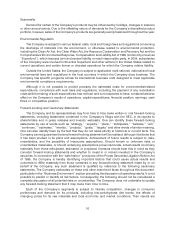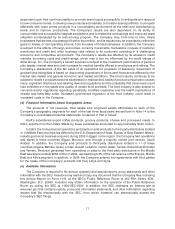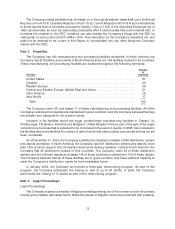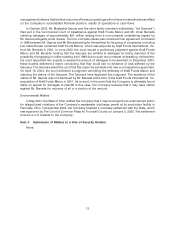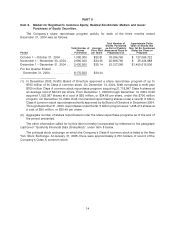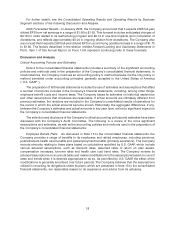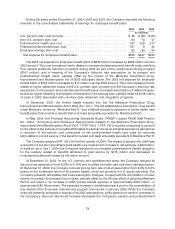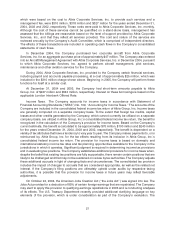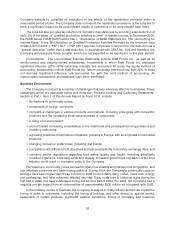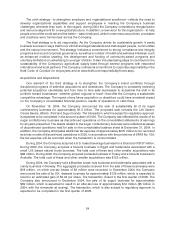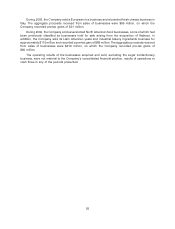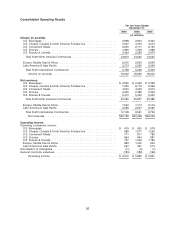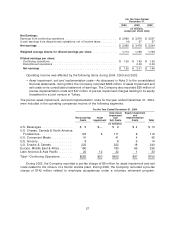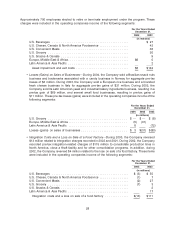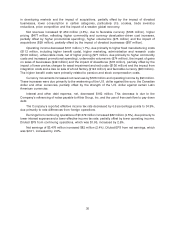Kraft 2004 Annual Report Download - page 21
Download and view the complete annual report
Please find page 21 of the 2004 Kraft annual report below. You can navigate through the pages in the report by either clicking on the pages listed below, or by using the keyword search tool below to find specific information within the annual report.expense by approximately $65 million. Similarly, a fifty-basis point decrease (increase) in the expected
return on plan assets would increase (decrease) the Company’s pension expense for the U.S. pension
plans by approximately $31 million. See Note 15 to the consolidated financial statements for a sensitivity
discussion of the assumed health care cost trend rates.
Revenue Recognition. As required by U.S. GAAP, the Company recognizes revenues, net of sales
incentives, and including shipping and handling charges billed to customers, upon shipment of goods
when title and risk of loss pass to customers. Shipping and handling costs are classified as part of cost of
sales. Provisions and allowances for estimated sales returns and bad debts are also recorded in the
Company’s consolidated financial statements. The amounts recorded for these provisions and related
allowances are not significant to the Company’s consolidated financial position or results of operations.
Depreciation, Amortization and Goodwill Valuation. The Company depreciates property, plant and
equipment and amortizes definite life intangibles using straight-line methods over the estimated useful
lives of the assets.
The Company is required to conduct an annual review of goodwill and intangible assets for potential
impairment. Goodwill impairment testing requires a comparison between the carrying value and fair
value of each reporting unit. If the carrying value exceeds the fair value, goodwill is considered impaired.
The amount of impairment loss is measured as the difference between the carrying value and implied fair
value of goodwill, which is determined using discounted cash flows. Impairment testing for
non-amortizable intangible assets requires a comparison between fair value and carrying value of the
intangible asset. If the carrying value exceeds fair value, the intangible asset is considered impaired and
is reduced to fair value. These calculations may be affected by the market conditions noted below in the
Business Environment section, as well as interest rates and general economic conditions. During 2004,
the Company completed its annual review of goodwill and intangible assets. This review resulted in a
$29 million non-cash pre-tax charge related to intangible asset impairments for a small confectionery
business in the United States and certain brands in Mexico. A portion of this charge, $12 million, was
recorded as asset impairment and exit costs on the consolidated statement of earnings. The remainder
of the charge, $17 million, is included in discontinued operations.
Impairment of Long-Lived Assets. The Company reviews long-lived assets, including amortizable
intangible assets, for impairment whenever events or changes in business circumstances indicate that
the carrying amount of the assets may not be fully recoverable. The Company performs undiscounted
operating cash flow analyses to determine if an impairment exists. For purposes of recognition and
measurement of an impairment for assets held for use, the Company groups assets and liabilities at the
lowest level for which cash flows are separately identifiable. If an impairment is determined to exist, any
related impairment loss is calculated based on fair value. Impairment losses on assets to be disposed of,
if any, are based on the estimated proceeds to be received, less costs of disposal.
Marketing and Advertising Costs. As required by U.S. GAAP, the Company records marketing
costs as an expense in the year to which such costs relate. The Company does not defer amounts on its
year-end consolidated balance sheet with respect to marketing costs. The Company expenses
advertising costs as incurred. Consumer incentive and trade promotion activities are recorded as a
reduction of revenues based on amounts estimated as being due to customers and consumers at the
end of a period, based principally on historical utilization and redemption rates. For interim reporting
purposes, advertising and consumer incentive expenses are charged to operations as a percentage of
volume, based on estimated volume and related expense for the full year.
Related Party Transactions. As discussed in Note 4 to the consolidated financial statements, Altria
Group, Inc.’s subsidiary, Altria Corporate Services, Inc., provides the Company with various services,
including planning, legal, treasury, accounting, auditing, insurance, human resources, office of the
secretary, corporate affairs, information technology, aviation and tax services. Billings for these services,
20


